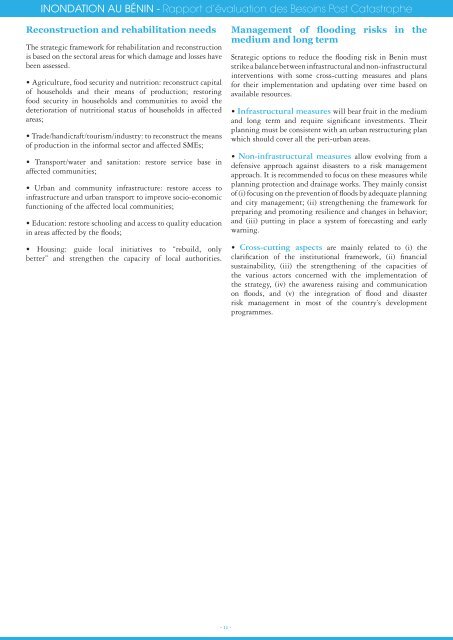INONDATION AU BéNIN - Rapport d'évaluation des ... - GFDRR
INONDATION AU BéNIN - Rapport d'évaluation des ... - GFDRR
INONDATION AU BéNIN - Rapport d'évaluation des ... - GFDRR
You also want an ePaper? Increase the reach of your titles
YUMPU automatically turns print PDFs into web optimized ePapers that Google loves.
<strong>INONDATION</strong> <strong>AU</strong> Bénin - <strong>Rapport</strong> d’évaluation <strong>des</strong> Besoins Post Catastrophe<br />
Reconstruction and rehabilitation needs<br />
The strategic framework for rehabilitation and reconstruction<br />
is based on the sectoral areas for which damage and losses have<br />
been assessed.<br />
• Agriculture, food security and nutrition: reconstruct capital<br />
of households and their means of production; restoring<br />
food security in households and communities to avoid the<br />
deterioration of nutritional status of households in affected<br />
areas;<br />
• Trade/handicraft/tourism/industry: to reconstruct the means<br />
of production in the informal sector and affected SMEs;<br />
• Transport/water and sanitation: restore service base in<br />
affected communities;<br />
• Urban and community infrastructure: restore access to<br />
infrastructure and urban transport to improve socio-economic<br />
functioning of the affected local communities;<br />
• Education: restore schooling and access to quality education<br />
in areas affected by the floods;<br />
• Housing: guide local initiatives to “rebuild, only<br />
better” and strengthen the capacity of local authorities.<br />
Management of flooding risks in the<br />
medium and long term<br />
Strategic options to reduce the flooding risk in Benin must<br />
strike a balance between infrastructural and non-infrastructural<br />
interventions with some cross-cutting measures and plans<br />
for their implementation and updating over time based on<br />
available resources.<br />
• Infrastructural measures will bear fruit in the medium<br />
and long term and require significant investments. Their<br />
planning must be consistent with an urban restructuring plan<br />
which should cover all the peri-urban areas.<br />
• Non-infrastructural measures allow evolving from a<br />
defensive approach against disasters to a risk management<br />
approach. It is recommended to focus on these measures while<br />
planning protection and drainage works. They mainly consist<br />
of (i) focusing on the prevention of floods by adequate planning<br />
and city management; (ii) strengthening the framework for<br />
preparing and promoting resilience and changes in behavior;<br />
and (iii) putting in place a system of forecasting and early<br />
warning.<br />
• Cross-cutting aspects are mainly related to (i) the<br />
clarification of the institutional framework, (ii) financial<br />
sustainability, (iii) the strengthening of the capacities of<br />
the various actors concerned with the implementation of<br />
the strategy, (iv) the awareness raising and communication<br />
on floods, and (v) the integration of flood and disaster<br />
risk management in most of the country’s development<br />
programmes.<br />
- 11 -

















